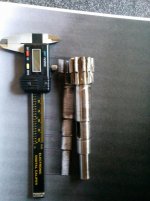Impact-vector
Plastic
- Joined
- May 12, 2012
- Location
- Atlanta GA
I currently have a lathe with a metric rack and finding an 11 tooth pinion is proving to be hard!
If I changed the rack and pinion to a new mesh ratio- besides my dials being off- would there be any other issues?
Current pinion is shot and the rack has some bad teeth.
Thanks
~J
If I changed the rack and pinion to a new mesh ratio- besides my dials being off- would there be any other issues?
Current pinion is shot and the rack has some bad teeth.
Thanks
~J




